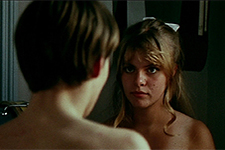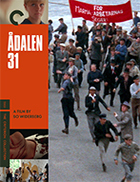Ådalen 31
|  For writer/director Bo Widerberg, there was no question about the need for a film about the Ådalen shooting, which occurred in the Swedish sawmill district of Ådalen in 1931 and resulted in the deaths of five strikers and a seismic shift in the country’s center of political power. “It’s one of the turning points in our country’s history,” he declared in a 1968 interview. “You have to make a film about it. You simply have to.” He had decided that he wanted to make the film while he was completing editing on his second feature, Raven’s End (Kvarteret Korpen, 1963), but it took four years to make it a reality. The resulting film, Ådalen 31, was a resounding international success, winning the Grand Jury Prize at the Cannes Film Festival and netting an Oscar nomination for Best Foreign Language Film. It took some lumps from critics who demanded that its revolutionary qualities surpass its artistic qualities and also from critics who felt that its politics were too didactic. Some of the critical barbs regarding the film’s aesthetics were sharpened by the fact that Widerberg was best known internationally for the beautifully shot, lyrical romantic tragedy Elvira Madigan (1967), rather than his earlier, gritty social-realist dramas like The Baby Carriage (Barnvagnen, 1963). And it is true that his overall concept of the capital-versus-labor tension is not too far removed from 1920s Soviet agitprop films, which frequently depicted pre-revolution factory owners as portly, cigar-chomping villains and the workers as noble, upstanding exemplars of grounded humanity. However, while Widerberg’s political sympathies are certainly evident, he is no purveyor of simple caricature, instead allowing for some nuance in his portrayal of various characters on both sides of the conflict. To give the historical atrocity a more intimate, human dimension, Widerberg grounds it in a fictional narrative involving the Andersson family, whose father, Harald (Roland Hedlund), is on a sympathy strike to support workers in the local pulp mill who are striking against their wages being reduced. He and his wife, Karin (Kerstin Tidelius), manage their family well despite the hard times, which is a change for Widerberg, whose previous depictions of nuclear families leaned heavily into tension and dysfunction. There is a real sense of warmth in the Andersson home as they struggle to make ends meet without a paycheck, and Widerberg is often at his cinematic best when visualizing the dignified everyday routines of their working-class life, whether it be washing the front steps or serving a bigger-than-usual meal. The Anderssons’ oldest son, Kjell (Peter Schildt), is a teenager who has an office job at the local saw mill and falls in love with the owner’s daughter, Anna (Marie De Geer). Much of the narrative involves Kjell and his best friend Nisse (Jonas Bergströ) trying to figure out the opposite sex, which gives the film a coming-of-age dimension, parts of which have not aged terribly well. It is understandable that Kjell and Nisse are consumed with trying to understand girls and erogenous zones, but the scene in which Nisse hypnotizes a girl into a deep sleep and takes off all her clothes—which is most likely responsible for the film’s X rating from the MPAA—plays very creepy today. The painterly romanticism of Elvira Madigan is certainly present here in the depiction of the relationship between Kjell and Anna, and Widerberg conveys a real of sense of beauty in young, inexperienced love, even as it results in an unexpected pregnancy (a social reality that played a major role in both The Baby Carriage and Raven’s End, as well). The blunt, practical response of Anna’s mother (Anita Björk) to her teenage daughter being pregnant radically realigns her character, as we had previously seen her as a teacher to Kjell, instructing him in French Impressionism. There is a sudden coldness there that dovetails with Widerberg’s depiction of the sawmill owners, whose practicality and concerns with their own economic status are fundamental to the oppression of the working class. Widerberg and cinematographer Jörgen Persson, who also shot Elvira Madigan and would go on to a prolific career, shooting several more of Widerberg’s films and eventually working with Lasse Hallström and Bille August, move confidently between a lyrical, impressionistic aesthetic and a documentary-like approach, especially once the workers start marching and the bullets start flying. Widerberg is blunt with the film’s violence, and he also uses it to complicate any simple good-versus-evil dichotomies we might want to draw (or assume he is drawing). The Swedish military, who are deployed to protect the workers brought in by the mill owners to replace the striking workers, are clearly in over their heads and not prepared to managed a civilian protest. Their very presence relates directly to the violent actions of the striking workers, who attack the scabs in increasingly vicious ways and even turn on Harald when he attempts to render medical aid to one of them who is bleeding and in fear for his life. The film does more than just imply that violence begets more violence, and Widerberg can’t help getting explicitly didactic in the film’s closing moments, using Kjell as a mouthpiece for the argument that education is key to raising the social and economic prospects of the working class and finding some common ground of equality. It is a good argument, but one that you can’t help but wish that Widerberg had made in a less self-conscious display.
Copyright © 2023 James Kendrick Thoughts? E-mail James Kendrick All images copyright © The Criterion Collection | |||||||||||||||||||||||||||||
Overall Rating: 

 (3)
(3)


 This four-disc Blu-ray set contains four films: The Baby Carriage (1963), Raven’s End (1963), Elvira Madigan (1967), and Ädalen 31 (1969).
This four-disc Blu-ray set contains four films: The Baby Carriage (1963), Raven’s End (1963), Elvira Madigan (1967), and Ädalen 31 (1969).